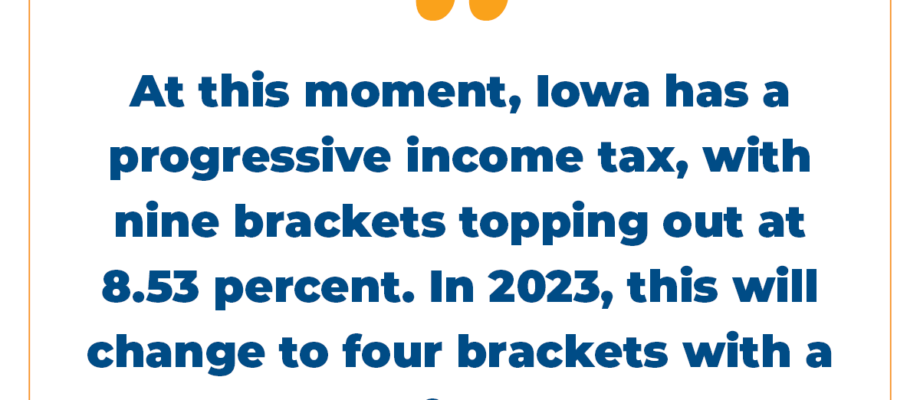
With a healthy state budget, lower income and corporate tax rates, the elimination of retirement income tax, and the legislature eyeing property tax reform, 2023 should be a great year for taxpayers.
Iowa taxpayers will start seeing income tax relief in just a few weeks as a result of the historic tax reform the legislature passed and Governor Kim Reynolds signed into law this year. At this moment, Iowa has a progressive income tax, with nine brackets topping out at 8.53 percent. In 2023, this will change to four brackets with a top rate of 6.5 percent. By 2026, Iowa will transition to a 3.9 percent flat tax. Retirees won’t have to wait that long, however, because retirement income will not be subject to state taxation in Iowa as soon as the clock hits midnight this December 31.
Additionally, Iowa’s corporate tax rate of 9.8 percent will be lowered to 8.4 percent in the coming year. The corporate tax rate will eventually phase down to a flat 5.5 percent. This is in addition to the continuing phase-out of the inheritance tax.
In 2022, Iowa led the nation in tax reform enactments, as a leader in what has become known as a “flat tax revolution.” Other states whose residents will see major tax relief in 2023 include:
Other major state tax reforms will surely be enacted in 2023. North Dakota Governor Doug Burgum, for example, has recently outlined a pro-growth tax reform that, if passed, would create a 1.5 percent flat tax — the lowest in the nation!
The United States will benefit by the continued spread of this “revolution,” and states such as Iowa and North Carolina are demonstrating how tax reform can be done responsibly. For several years, North Carolina has been the gold standard in state tax reform, having lowered income tax rates while controlling spending. This is the formula for success: prudent budgeting and gradually lower rates.
This year, Governor Reynolds and the legislature have not only made Iowa’s tax code more competitive, but also followed prudent budgeting principles. The fiscal conservatism of state officials has allowed pro-growth tax reforms. Iowa is on track for a $1.9 billion budget surplus and $830 million in reserves. The Taxpayers Relief Fund will have a balance of $1.6 billion, which is projected to increase.
The model of wise budgeting and lower tax rates has strengthened the economy and established a strong fiscal foundation for government operations. Moving forward, signs indicate that Governor Reynolds and the legislature understand Iowa is in competition with other states, creating opportunities for further reform, such as lowering the 3.9 percent flat tax rate.
The legislature is also poised to make property tax reform a priority for action in 2023. High property taxes affect both individuals and businesses, and they deserve, and are demanding, property tax relief.
As big a year as 2023 will be for Iowa taxpayers, it should only be the start of a groundbreaking decade!
